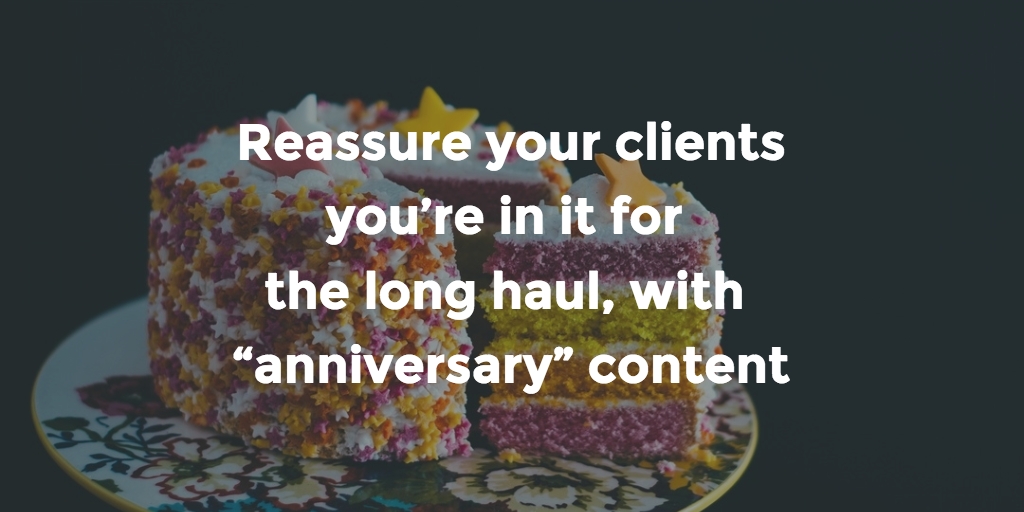One way to do this is through what I call “anniversary newsjacking” content.
For a bit of background: Newsjacking, which I covered in Post #6, involves focusing your articles, speeches and other content on news that matters to your prospects and clients. It’s a good way to make sure that the information you provide meets the actual needs of the people you want to reach. And, there’s a chance that someone will be doing an online search for information on that bit of news – and learn about you in consequence.
Anniversary newsjacking means creating content around the news, but on an anniversary of it. News reporters have been doing this for centuries. “A year after the big flood – what’s changed in Jonestown?” might be a typical headline.
We’ll look first at the “how” of anniversary newsjacking, then the “why.” Yes, I know that’s backwards, but bear with me. I have reasons.
How to prepare “anniversary” content
Most reporters, who build newsjacking content, do it as part of their “beat,” which is an area of interest or topic that they’re responsible for “covering,” or creating news stories about. Going back to the example of a flood, they’d put a note in their calendar for one year ahead, reminding them to consider preparing a story about the flood and what’s changed in the community since then. Like, maybe the town did actually start to enforce laws against building on a floodplain.
You can use this idea too. Here’s how.
Make note of events that are noteworthy in the lives of the people you want to serve. This could be a new law, a regulation, a legal judgment, new technology, the launch of a new competitor, or other such event. Remember that it’s not so much something that matters in your world, but something that matters in THEIRS. You aren’t your client.
How do you find these events? Well, you do what you should always do when meeting the needs of a market – you read their trade media, follow the leading lights on Twitter, subscribe to influential blogs, attend conferences and industrial meetings, and basically stay in touch.
Then you put notes into your calendar, giving yourself enough time to prepare the blog post, article, speech or other content initiative. You schedule the launch time for the anniversary you’re considering.
What period should you consider? Well, a year seems like a good plan but, not always. In information technology, a year is a lifetime. So, if you’re discussing the launch of a new version of some software your market uses, your first sentence might be something like, “It’s been a month since the launch of version 2.0. How’s it working out in practice?”
In this, the “anniversary” is combined with a review (see Post #10 for more on how “review” content can help you build trust and show longevity) to provide good value to the reader.
But in other cases, a year may be too short a time. I worked recently with an aquatic biologist with whom I’d developed an analysis of a new federal Act around protecting fishery resources. The article was for a mining publication and talked about how this new Act would affect mining operations (just in case the connection isn’t clear to you – mining operations almost always cause changes to watercourses and water tables, and in most places they must create compensatory aquatic habitat to balance those effects).
I got in touch with my biologist client a few months later, suggesting that we write an article for the new Act’s one-year anniversary. He replied that it was too early – the Act would only be effectively tested by a few cases that went through the Supreme Court, and that wouldn’t be completed for three or four years. So, I’ve scheduled to give my client a call at that time.
Here’s how you design effective anniversary content:
• Describe the event, and the circumstances that launched it
• Give your analysis of how the event’s effects have played out in the lives of people in your market
• Give your informed opinion on how the event’s effects will continue to manifest themselves
• Make your recommendations on how to avoid a problem or gain a benefit as a result of the change (I call this “greed and fear” and have covered this in Post #24)
Why “anniversary” content helps you build trust
Okay, that’s the “how.” Now, the “why.” Why is anniversary content a good thing? Mostly, because it shows that you’re paying attention to events that matter to your clients, that you’re part of their world, and you care about them. That’s huge.
Anniversary content also shows that you’re invested for the long haul. It’s not just that you’ve been serving that target business community for some time. It’s that you’ve taken the trouble to prepare a speech, video, blog post or other content that helps them do their jobs better. That’s even huger.
As with most types of content, feel free to multi-task. You can present your ideas in a variety of formats, which should be based not so much on your preferred forms of getting your message across, but in your clients’ preferred ways to receive it.
Just a note on timing – be sure you’re not too late with your content, particularly if you’re presenting a trade publication editor with your idea. Magazines usually work four or five months in advance. So for example, if this is August, you should be presenting ideas for an issue in about November or so.
So if you’re ever stuck for a blog topic, or you’ve been asked to write an article but have no idea what to write about, think of what was happening in the lives of your clients a year ago, and see if that sparks any ideas.


